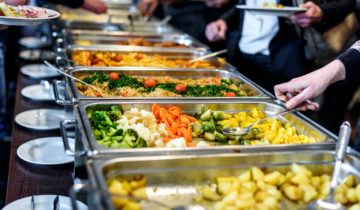Dark kitchens: Genesis, advantages and impact on traditional restaurants
Whether you call them cloud kitchens, ghost kitchens, dark kitchens or something else, those different labels all refer to the same concept: a restaurant with its “service” aspect stripped away, limited to a kitchen that produces meals exclusively for delivery (or takeaway). This American concept blends the business models of “pure players” (companies with no physical sales locations) and centralized kitchens to capitalize on the boom in food delivery platforms and the decline of experiential restaurants.
The dark kitchen was originally… a crude hoax
The first occurrence of the expression “ghost kitchen” can be traced back to an NBC New York article posted in 2015. At that point, the terms described a deceptive trend identified by the investigative team: owners of some of the city’s top delivery restaurants were listing their establishments under several different names in meal delivery apps in order to boost their visibility. Some of them were simply private kitchens, with no dining room, service or registered name. Those kitchens had never had a health inspection and had no business permit. That discovery, which received vast media attention, marked a toughening of inspections and of the legal liability of food delivery apps in the States.
This crude deception did however give American entrepreneurs some ideas, leading to a legal version of the business model. Nowadays, “ghost”, “dark” or “cloud” kitchens are professional facilities that prepare meals for delivery or takeaway (ordered online or in an app). Two models coexist today:
- Branded dark kitchens, which have their own brand name under which they sell their dishes via an in-house delivery service or an aggregator
- Shared dark kitchens, whose kitchen and premises are used as overflow facilities by one or several established restaurants.
Lower cost prices and enhanced data analysis: A winning combination
There are several factors behind the success of dark kitchens. The concept reduces “barriers to entry” into the food service industry, because less of an initial investment is required: the premises are smaller, there is no real need for visibility of the physical location, and no dining service means savings in terms of furnishings, dishes, washing up, personnel and personnel management, and the list goes on. The premises are laid out to optimize dish preparation times, usually by means of technologies and processes inspired by fast food giants.
With cost prices that are significantly lower than at sit-down restaurants, dark kitchens are competitive and can achieve attractive profit margins. Another major advantage of this digitized context is the fact that dark kitchens can collect, sort, analyse and interpret customer data in order to make informed decisions based on their target audiences’ preferences and major trends (menu contents, pricing, preparation and delivery time, etc.).
Dark kitchens in France: How do they fare in the land of fine dining?
Many restaurants in France became de facto dark kitchens to limit the damage caused by the pandemic in 2020 and 2021. Will this first contact give restaurant patrons ideas? Perhaps, but for the time being, dark kitchens (in the strictest sense of the term) are only in their infancy in France. In an interview he gave with Business Insider France, the founder of the Food Service Vision consultancy François Blouin described the concept as “very new and still small compared to the rest of the market”. His firm estimates the number of dark kitchens in the country at 400, “primarily in Paris but also in big cities like Bordeaux, Lille, Lyon and Marseille, where they are growing substantially”, as François Blouin explains.
Do dark kitchens pose a threat to traditional restaurants?
Dark kitchens do not promise the same things as sit-down restaurants. They offer convenience, with a business model focusing on fast service and practicality rather than an experience. In other words, dark kitchens are not competing directly with restaurants… but they are expanding the range of alternatives offered by food delivery aggregators. Those platforms are pushing restaurants to rethink their menus and their organization in order to remain in line with the latest dietary habits, by offering dishes that travel well, are easy to prepare and are still profitable after deducting their delivery platforms’ commission or direct delivery expenses.
To help you and your business adapt, Cocotine has created a special takeaway cookbook of inspired recipes that are easy to prepare.






